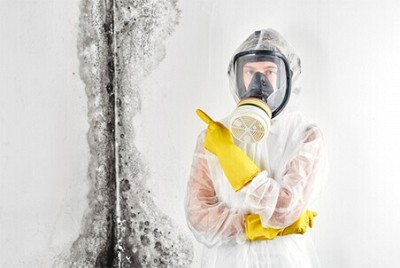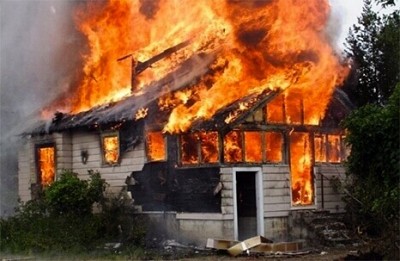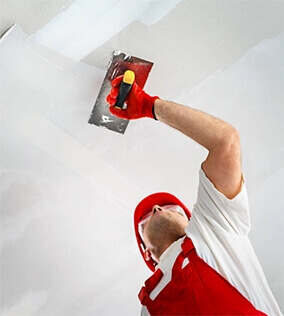Mold Glossary
Mold is a complicated subject. If you're inquiring about mold removal services, from black mold removal to inspections and mold removal costs. Use our glossary to understand more about mold and related terminology. If you have a specific mold-related question, reach out to the Canada's Restoration Services team, Toronto & Canada's leading mold removal company.
Acremonium: Acremonium molds start off as a moist, white substance and later turn into a powdery texture. These molds can look pink, brown, white, or any shade in between, and are often found in air conditioning systems, humidifiers, and other damp areas. Some species can produce mycotoxins and pose health risks that need to be addressed quickly by mold removal experts.
Aspergillus: This is a type of mold or fungus that is found incredibly often during attic and bathroom mold removal. Aspergillus is a genus of mold that can be commonly found in indoor and outdoor environments. It typically has a powdery appearance and varies in color from green to yellow. Many sub-species of Aspergillus can produce mycotoxins that may lead to respiratory issues in sensitive individuals, as such mold removal services are required to eliminate the infestation and health implications. Breathing in Aspergillus spores can affect people with weaker immune systems leading to lung and sinus infections.
Air Quality: Air Quality or indoor air quality is an important measure of how chemicals and contaminants in the air, like mold interfere with the contamination, cleanliness, and safety of the air you breathe. Air quality is measured indoors and outdoors in relation to mold testing and mold inspections.
Air Testing: Air testing or air sampling is a type of mold testing that is used to measure the number of mold spores that exist outside in the natural environment compared to indoor spaces exposed to mold infestations.
Allergen: A substance of particles that triggers an immune response in the body, from physical rashes and hives to anaphylaxis and difficulty breathing. Mold spores are naturally occurring allergens that can trigger varying degrees of allergic reactions.
Alternaria: Alternaria molds are typically dark green or brown and have a velvety texture, and are often found in damp areas like bathrooms and kitchens. Prolonged exposure to Alternaria can trigger allergies and asthma symptoms. If you spot signs of Alternaria, it’s safest to contact a restoration company for mold inspections and remediation.
Attic Mold: Attic mold removal refers to infestations that frequent the attic and roof cavities. This is one of the most common calls for residential mold removal services due to the environment comprising a surplus of organic materials and the potential for leaks.
Aureobasidium: Aureobasidium molds are pink, black, or brown and typically grow on damp window frames, caulking, and wooden surfaces. They can trigger allergic reactions and asthma symptoms such as wheezing or trouble breathing in sensitive individuals. If you notice wood rot, especially after a water damage incident, contact a trusted restoration company.
Black Mold: Most known for being the scariest or most intimidating type of mold, i.e. toxic mold. There are various species of black mold, but the most notorious is Stachybotrys Chartarum. Most people can determine whether they need black mold removal by keeping an eye out for black, dark, and velvet spotting around their property.
Bathroom Mold: Because of the surplus of organic material and pipes, leaks and humidity is the leading reason both commercial and residential property owners require bathroom mold removal. Bathroom mold infestations usually start in the grout of shower and floor tiles, but they can also move through drywall, flooring, cabinetry, and more.
Cellulose: An organic substance with a plant base that is commonly used for attic and wall insulation. Due to its organic makeup, cellulose is frequently infested by mold.
Chaetomium: Chaetomium molds have a cotton-like or fluffy texture. Chaetomium outbreaks can range in colour from white to gray to brown. These outbreaks most commonly occur in and around building materials that have been compromised by water damage. Extended exposure to Chaetomium can cause health issues for individuals with compromised immune systems.
Cladosporium: Cladosporium molds are dark-colored and have a suede-like texture. Outbreaks of this species can be found on fabrics, carpets, and other materials in damp environments. While they are not as highly toxic as some other species of mold, Cladosporium can trigger allergic reactions sun exposed like rashes, irritation, and difficulty breathing.
Colonies: A mold colony refers to a visible cluster or aggregation of mold growth. When mold spores find suitable conditions for growth, typically consist of thousands or even millions of mold spores that have grown into a visible mass.
Contamination: The presence of a harmful or unnatural substance in an environment where it doesn't belong. Mold spores producing colonies indoors on building materials are a contamination.
Curvularia: Curvularia molds are dark-colored and have distinctive curved spores, and can have different colors, ranging from dark green to brown. Cruvularia molds can be found on plants, soil, and damp building materials. While they are not highly toxic, they can cause allergies and respiratory issues. This species of mold can be found in bathrooms, kitchens, laundry rooms, basements, and other areas that are vulnerable to moisture, ventilation trouble, and heat.
Environmental Assessment: An environmental assessment is a government-regulated process that seeks to identify, anticipate, and evaluate the potential environmental effects of a given project. Before proceeding with mold removal, it's vital that contractors understand other risks a property presents.
Fungi: A type of spore-producing group of organisms that exist in the soil. Mushrooms, mold, cheese, and yeasts are all examples of fungi. Mold is a hazardous form of fungus that can find its way into enclosed spaces and indoor environments where they infiltrate the air.
Fusarium: Fusarium molds can appear pink, white, or red, and are often discovered in water-damaged construction materials, as the result of burst pipes, flooding, or other leaks. When outbreaks occur, Fusarium molds can produce harmful mycotoxins. Prolonged exposure to Fusarium may lead to eye, skin, and respiratory irritation.
Humidity: This measures the amount of water vapour in the air. Measured as a percentage, too much moisture indoors will trigger mold infestations. Indoor humidity levels can be measured with a hygrometer. Ideal humidity levels will vary depending on your location but should be, on average, between 30-50% humidity. Any more is a sign that you may need water damage restoration or mold removal.
Mold or Mould: The spelling of "mold" or "mould" will vary depending on where in the world you're located, with "mold" being the American variety, and "mould" the British spelling. Mold is a type of fungus that is a vital part of the natural decomposition process, but it can be very problematic in homes and commercial buildings.
Mucor: Mucor molds are white or gray and have a fluffy texture. They can grow on various organic materials and are commonly found in indoor environments with high humidity levels. This species of mold can be found on materials that have been overexposed to moisture like wood, cardboard, drywall, carpets, upholstery, and other building materials, as well as food.
Mycotoxins: This is the toxic substance output produced by many species of mold. Mycotoxins are released as mold spores are released into the air, contaminating the indoor environment and leading to poor air quality. When exposure via inhalation or ingestion causes illness, it results from the mycotoxins. Reducing the release of mycotoxins into the air is just one of many reasons early mold removal is vital.
Organic: In regard to mold, organic is a term used most often to describe the building materials used in construction made with wood, cellulose, or other naturally occurring substances. Organic materials act as a food source for mold spores and facilitate the formation of hazardous colonies.
Penicillium: Penicillium molds are recognized by their blue or green fuzzy appearance. They are often found on food items like bread and fruits, however many studies and mold inspections have found that species of penicillium mold can be found in building materials especially after flood or water damage.
Porous: A surface that is not completely solid. "Porous" refers to a material that has holes in it or is permeable. In some cases, these holes are not as visible as they could be in other instances. Both wood, drywall, and loose-fill insulation are porous, which allows spores to get trapped more easily.
Remediation: This is the process of stopping the damage caused by mold infestations and reversing its impact on the indoor environment. Remediation includes identifying, containing, removing, and taking action to prevent future incidents. In many cases, "mold remediation" is used interchangeably with "mold removal"
Removal: Simply, removal is the act of eliminating something that is unwanted. Mold removal is the act of entirely detecting and eradicating mold colonies, hidden and visible from an indoor space.
Restoration: This is the follow-up to mold removal or mold restoration, where building materials and elements damaged by infestations are repaired or replaced, going hand-in-hand with a comprehensive mold remediation approach.
Rhizopus: Rhizopus molds are fast-growing and typically white or gray. They can be found on various organic materials like fruits, vegetables, and bread. In some cases, they can cause food spoilage, but Rizopus molds can also infect building materials, causing serious damage.
Spores: Small, often microscopic units responsible for the reproduction of molds. Spores are released into the air and multiply where they land when the conditions are conducive to growth.
Stachybotrys Chartarum: This is the scientific name for the most common toxic black mold. It can be identified by its dark colour, spotted patterning, and pungent odour. It grows on materials with high cellulose content, including fiberboards, drywall, and paper. Black mold is known for its slimy black appearance. This species of toxic black-mold is commonly the product of water-damaged buildings. Stachybotrys Chartarum is notorious for its ability to produce harmful mycotoxins that lead to a wide spectrum of health issues especially in those that are . Proper removal and remediation are necessary when dealing with black mold.
Trichoderma: Trichoderma molds are identifiable by their white colour and patches of green or blue. They are commonly found in both indoor and outdoor environments around damp areas, infesting wet or humid building materials.
Ulocladium: Ulocladium molds are black and can appear slimy or powdery in texture. They are often found in areas with high moisture or humidity levels and where there is poor ventilation, such as bathrooms and kitchens. More often than not, Ulocladium is the result of water damage or flooding indoors.
Ventilation: Ventilation refers to the intentional supply of air to and from an indoor space. Ventilation plays a significant factor in mold infestations and can often be pointed to as an underlying reason why a property owner needs attic mold removal. Ventilation allows mold spores to freely flow out of a building, but when blocked or insufficiently ventilated, mold spores are more likely to settle in a property.







